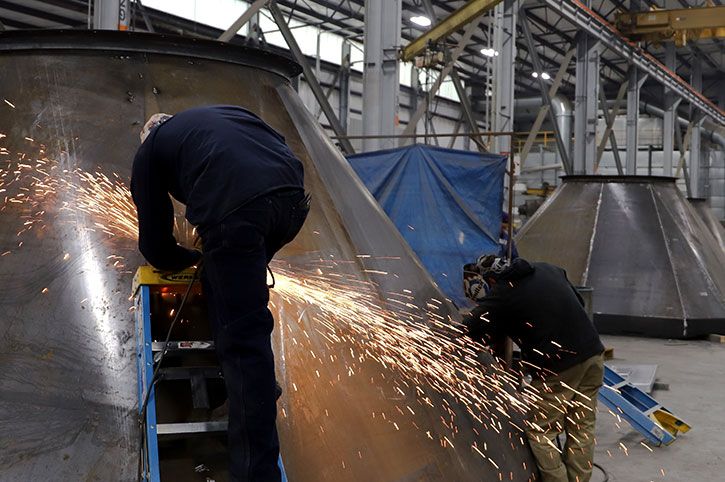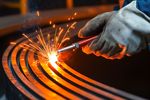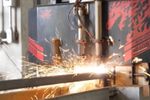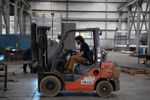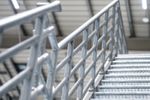As more American manufacturing workers retire, there’s a growing demand for fabrication welders to help create the metal equipment and machinery that construct our nation’s bridges, highways, and buildings.
With annual median salaries in the $40,000 range and more high schools and community colleges offering hands-on training, a welding career can offer big perks without the giant price tag of a four-year college degree. In fact, according to career expert site Zippia, welders who enter the field don’t remain in their initial positions very long.
However, just because fabrication welding training is financially attainable and opportunities for advancement are available, doesn’t mean the job is an easy way to earn a living. It takes extensive training to master the high-powered tools needed to melt, heat, and mold a variety of materials. Fabrication welders must also learn how different materials react to heat, composites, and alloys.
Most importantly, new welders must learn how their individual tasks fit into the big picture of a larger fabrication project according to Kellie Bailey, Human Resources Manager at Southern Metal Fabricators.
“Proper welding is more than just learning how to run a bead,” says Bailey. “You’re not just putting one piece together. Your piece is part of a larger, complex process.”
How Welding Plays Into the Metal Fabrication Picture
Being able to master various welding techniques is critical to any metal fabrication project. But according to Bailey, involving welders at the beginning of each fabrication project is vital to a successful outcome. At Southern Metal Fabricators, welders are involved as early as possible in every project, beginning with reviewing the engineering drawings to gain an understanding of how the entire fabrication will function in the real world.
For example, fabrication welders must first learn how a steel industrial staircase will work once it’s installed, before they are allowed to weld a single piece. The welders are brought in before designs are finalized, and they are kept in the loop from cutting and forming to assembly and fabrication field installation.
Job Training Begins Before the First Weld
Not all community colleges and trade schools are created equal when it comes to fabrication welding training, according to Bailey. While one training program may focus on cutting small swatches and learning how to bead, another may just teach cutting, welding, and grinding based on a few standard layouts and prints.
“Unfortunately, not all welders are given comprehensive training from the fundamentals through all the key steps you’d experience on the fabrication floor,” says Bailey. “Many of them are not learning the full progression of what they’re actually fabricating.”
New welders at Southern Metal Fabricators are trained in proper grinding, how to grid, and surface preparation techniques before they are allowed to even hold a weld. They first learn how different materials respond to welds and different heat variations. The entire metal fabrication process is explained to the welders, so they fully understand the complexities of the project being created.
Welding Techniques to Ensure Metal Fabrication Success
Unfortunately, some specific fabrication welding techniques taught in the schools do not meet today’s manufacturing QC standards. For example, many welders are still taught the “stacking dimes” technique, where the weld weaves back and forth for a stacked finish. Southern Metal Fabricator welders train instead to fill in the gaps to create a smooth surface for stronger bonding, and they learn how “push” welds work better than “pull” welds for filling in the gaps.
Until they are fully trained, new welders shadow more experienced fabrication welders on smaller projects, before they are allowed to tackle more complex projects. The seasoned welders show their proteges how to:
- Check grinds and tolerances.
- Determine if the material is properly deburred.
- Apply the appropriate tacking and fitting material.
- Read and decipher the layouts and ensure work instructions are followed to the letter.
- Follow safety best practices, such as not reaching above your head to weld, and how to properly use PPE such as gloves and safety glasses.
Welding QC Is Critical to Quality Metal Fabrication
At Southern Metal Fabricators, our welding team plays a key role in creating a successful result, especially when it comes to a metal assembly. Proper fabrication welding techniques are essential to ensuring all assemblies and subassemblies fit together as planned. Not a single project is completed without being vetted through our extensive Quality Control program, which mandates full assemblies are not shipped until they meet all welding certifications specified by our customers.
We also developed a formal Welding Procedure Specification (WPS) with World Testing, which conforms to ASME Section 9. All our welders are certified to fabricate carbon-steel tanks that conform to the API-650 standard, and our structural steel welding procedures follow the American Welding Society’s standard for carbon steel above 1/8” gauge and stainless steel above 1/16” gauge.
Every Southern Metal Fabricator customer has full access to our updated Quality Control policy to demonstrate our dedication to fabrication welding quality and adherence to assembly requirements.
If you want to learn more about how we are prepared to meet or exceed your quality expectations for custom metal fabrication, give us a chance to say, “Yes, we can do that!” by contacting us today.
